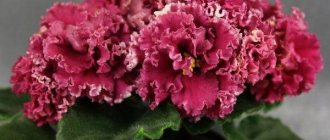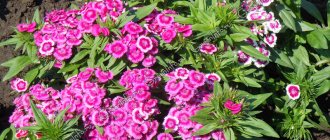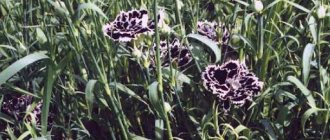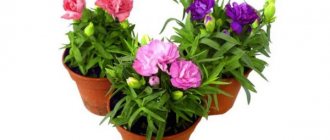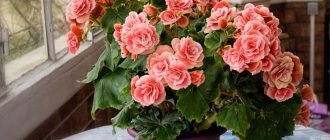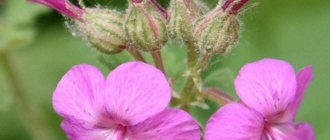Carnation grass - dianthus deltoides red - is a crop that is familiar to almost every gardener who has an excellent attitude towards alpine hills or rocky gardens, and who regularly designs them. The plant is distinguished by its complete unpretentiousness and the fact that it has very thin and fragile stems. But, nevertheless, they contain incredibly decorative emerald-colored foliage, which perfectly complements any composition and looks just as attractive at any time. During flowering, the grass carnation is without a doubt a work of art, as it is distinguished by its colorfulness, and the leaves have fresh and sometimes very unusual tora. Later they turn into cushion-shaped bushes that more closely resemble pink, white, and crimson clouds. In this article, we will dwell in a little more detail on what features this type of plant has, we will talk about the most popular and sought-after varieties, as well as how to properly plant carnation grass and care for it in order to get a truly excellent and worthy decorative result.
Description and features of the type of carnation Travyanka
Flowers are characteristic of carnation plants - they gradually expand from the base to the jagged edges. The capsule where the seeds are formed is located between the petals. This type of plant easily takes root on slopes and elevated surfaces due to the structural features of the root system. The grass grows in all directions, which makes it possible to stay on soils of this type. It is found in India, in Europe, and can also be seen near rivers and in the steppes.
The advantage is that the plant is quite resistant to disease, but sometimes young bushes suffer from insects and rodents.
Sowing seedlings
Turkish clove is a perennial plant. However, it is also cultivated as a biennial. The advantage of the method of propagation from seedlings is that flowers appear in the first year.
Preparing the soil for sowing seedlings
To sow seeds, prepare a substrate from the following components:
- peat and turf soil - 2 parts each;
- sand - 1 part.
Sand improves gas exchange in the soil, and peat provides seedlings with useful substances. This contributes to higher germination of Turkish cloves.
Before adding seeds, the soil is frozen. This measure gets rid of weeds, pests and parasites. For this purpose, the substrate is placed in the freezer and kept for 5 days at a temperature of -15 °C. If weather conditions permit, then the bag with the soil mixture is simply placed outside. After deep freezing, the mixture is moved to heat for a week, and then this cycle is repeated.
The second method of disinfection is steaming. Place a large saucepan or bucket on the stove, add water and bring to a boil. A grate is placed on top of the container, on which the soil mixture is placed, placed in several layers of gauze. Treat the substrate with high temperature for 90 minutes. Immediately before sowing the seeds, water the ground with a weak solution of potassium permanganate.
Growing seedlings
To obtain seedlings, cloves are sown in February. The container is first doused with boiling water or a solution of potassium permanganate to reduce the likelihood of developing fungal infections. A drainage layer is laid on the bottom, for which gravel, expanded clay, and fragments of broken ceramic dishes are used. As a last resort, crushed polystyrene foam is used.
Gardening stores sell special drainage materials. In addition to maintaining a certain level of humidity, they also perform another task - they protect the soil from toxic substances and heavy metal salts.
The seeds are placed in the prepared soil to a depth of 1 cm, maintaining a distance of 2–3 cm between them. At the first stage, the container is placed in a room with a temperature of about 17 °C. Cover the container with paper or film, periodically ventilate and spray water on the surface. When shoots appear, the seedlings are moved to a room with a temperature of about 15 °C, but with good lighting. Higher temperatures will provoke rapid growth, which will affect the decorative appearance of the bush.
Reference. The sowing density for all plants is determined as follows: 2–3-week-old seedlings should not completely shade the ground with foliage.
When 3 leaves appear from the ground, the bushes are planted in separate pots filled with a soil mixture similar to the mixture for sowing seedlings. Before planting in open ground, young plants are first taken out into fresh air for 2–3 hours. The dishes with sprouts are left in the shade, hidden from direct sunlight. The holding time is increased every day. At night, the pots are left near the window with the window open. This allows the culture to get used to new conditions.
Seedlings are planted in open ground in the third or fourth week of May, when frosts are unlikely and the soil has warmed up sufficiently.
Attention! Turkish cloves do not tolerate transplantation very well. Therefore, when diving, it is better to place seedlings in pots, with which they are then transferred to open ground
Varieties of cloves Travyanka: characteristics of varieties
The table presents data describing the characteristics of each type of Carnation grass:
| View | Height, cm | Description | Flowers, flowering period |
| Wild growing | |||
| European | 20-40. | The leaves are dark green in color. Lifespan is approximately 6-9 years. Tolerates low temperatures down to -40 °C. Reproduction method: seeds and layering. Resistant to pests and diseases. | Five petals that grow from the beginning, the edges have a jagged shape. The color is red, hot pink and purple. Flowers, in the center of which many seeds are formed, are always collected in inflorescences. |
| Siberian | |||
| Indian | |||
| Breeding | |||
| Diamond | Approximately 15. | It has a pillow shape. Fast growing plant. The leaves are oblong, narrow, dark green in color, and have a white coating. Loves open, moderately moist, sunny places. This variety of carnation grass is resistant to temperatures down to -35 °C. | The flowers are cherry red. Mid-June – early October. |
| Toronto | Compact bush up to 15. | Prefers non-acidic soils, does not tolerate very wet places. The ideal temperature for seed germination is +14…+15 °C. Not resistant to cold weather. Removing faded flowers has a beneficial effect on further growth. | Five white feathery petals smoothly expand from the middle to the outer part of the flower; inside there is a crimson-red rim, which is characteristic of some varieties of Carnation grass. June August. |
| Variegated lawn | Around 17. | The ideal temperature for good growth is +15…+19 °C. The soil is non-acidic, drained, in which water does not stagnate for a long time, but flows out through the holes in the pot. | The color is white, pink and red. June August. |
| Allegory | 20-25. | One of the perennial species of Carnation grass. It has gnarled stems that often branch at the top. Almost the entire part of the plant is covered with plaque. They are grown by sowing in open ground, after the 7th day the first seedlings are already observed. | Carmine-red flowers 1.0-1.5 cm in diameter. June - August, after which it is recommended to cut off the flower stalks. |
| Flashing light | 40. | The entire length of the stems, like the leaves, are covered with small hairs. Prefers loamy garden soil containing clay and sand in its composition. | The petals are sharp-toothed and dark pink. June – September. |
| Canta libra | Low - from 10 to 15. | Fast breeding. Resistant to sub-zero temperatures. Grows well in sandy, moderately moist soils. | Graceful and large flowers of dark red shades. Beginning of June – end of September. |
| Sparkle | Up to 25. | An unpretentious plant that grows well in open areas with plenty of light. The leaves are narrow, covered with a gray coating. | Flowers are soft pink. Does not require special care Mid-July - end of September. |
| Arctic Fire | 20-25. | Age - one year. The plant is light-loving, drought-resistant, and tolerates severe frosts well. Quite often, this variety of Carnation grass is used in landscape design, planted under coniferous trees. | The flowers are large and have a pleasant aroma. Color: white and red June and September. |
| Dolly doll | 18-20. | Annual variety. Cold-resistant plant, prefers sunny areas and non-acidic soils. | The diameter of the white-red flowers is 4–6 cm. July – early October. |
Varieties and description
The different varieties are similar to each other, but their characteristics are slightly different.
Description of varieties of carnation grass:
- Splendence. A hardy plant that can bloom profusely in all weather conditions. It independently sows a seed around itself and grows rapidly.
- Diamond. The plant is well suited for planting a border or as a cover for a large area of soil. It blooms profusely, the stems are almost invisible. The flowers have a distinct aroma and rich pink color.
- Albus. White carnation, great for adding contrast to other varieties. Often grows together with carnations of the diamond variety.
To get a beautiful flower bed, it is best to plant several varieties of carnations. This will expand the color range and add brightness to the garden area.
Features of caring for Travyanka
Caring for the plant is not burdensome or difficult. Considering the fact that carnation grass is quite unpretentious, it is important that the flower does not grow in waterlogged soil (otherwise the roots will begin to rot, and this, in turn, will develop fungal diseases). It is also very important to apply phosphorus, magnesium, nitrogen and calcium fertilizers depending on the time of year.
Proper care of herbal cloves in open ground
Caring for carnations is easy. But in order for the plant to be healthy and delight with bright flowers, you need to know some of its features.
Watering and fertilizing carnations
For carnation grass, timely irrigation is very important. This is due to its superficial root system. Watering the plant should begin in early spring. On hot days, the number of procedures should be increased. But you should not overuse moisture, as this can lead to rotting of the root system.
Cloves should be fertilized comprehensively. In the spring, it is recommended to apply preparations based on nitrogen and phosphorus. In summer, the flower should be fed with magnesium and calcium. It would also be good to add a small amount of iron-containing mixtures to the soil.
If there is an excess of mineral fertilizers, the leaves may begin to turn yellow and fall off.
Possible pests
The plant is very rarely affected by fungus. But if young specimens grow in areas with high dampness, they may suffer from rust.
As for insects, caterpillars and mucus like to feed on cloves. In late autumn, mice infest the ground part. To prevent this, it is recommended to cover the bushes with pine branches.
Growing problems:
- Nematodes and woodlice. The best control method is insecticides. Agrosin is considered an effective drug. It must be used according to the instructions.
- Spider mite. It appears on bushes during the hot season. The tick feeds on sap from leaves and twigs. If nothing is done, the plant will begin to wither and dry out. Therefore, at the first signs of the disease, the shoots should be treated with garlic infusion or sulfur. Aldicarb also works well against ticks.
- Alternaria blight. A sign of the disease are long grayish-brown spots. From above they are abundantly covered with a dark coating. Severely affected leaves should be completely removed, and the plant itself should be treated with a fungicide.
Carnation grass is a very beautiful plant. If you follow all the recommendations, the flower will become a real decoration of any garden plot. The plant will also help to create a unique and unforgettable landscape design that will win the hearts of all guests.
Planting carnations Travyanka
Planting is one of the most important stages in the process of growing a flower. Despite the fact that most varieties of Carnation grass are perennial plants for open ground and do not require special care (Allegory is an example of such a variety), it must be replanted every 3-4 years.
This is necessary in order to preserve the decorative properties of the flower, namely the presentable appearance of the plant, since the bush grows chaotically and the decorative role disappears.
This plant loves dry, non-acidic soils. Before planting, the soil should be cleared of weeds, and the seedlings should be soaked in a chemical solution that protects against pests and diseases. If the gardener decides to plant Carnation grass in watery soil, it is worth adding limestone and sand.
Reproduction methods
A herbaceous plant for open ground, carnation grass, reproduces well by vegetative methods. Typically, two methods are used to propagate the crop.
Dividing the bush
Every few years, it is recommended to plant adult grass bushes by division. The reproduction procedure looks like this:
- The cloves are carefully dug out from well-moistened soil.
- Divide the root ball into 2-3 parts with feeding shoots and leaf rosettes on each.
- Remove all damaged parts of the plant and flower stalks.
- Plant the cuttings in the ground and water them properly.
The grass takes root quickly, and it is very easy to grow it on the site.
It is necessary to propagate the grass by division in the spring after frosts have passed.
Cuttings
The herb also successfully reproduces by cuttings. The procedure is carried out as follows:
- In early spring, shoots are taken from a healthy plant, making a lower oblique cut 3-5 cm from the tillering node, located closer to the root.
- Prepare a bed in a semi-shaded area, fertilizing the soil with sand and humus.
- Make grooves and pierce small holes using a stick.
- Place the stems in the recesses.
- Install a drip irrigation system for carnations.
- Cover the top of the bed with film and non-woven material.
After the cuttings begin to grow, first remove the film and then the shading. After two weeks of hardening, the culture is transplanted to a permanent site.
For high-quality engraftment of cuttings, carnations require about one and a half months
Growing Grass from seeds and seedlings
Annual and biennial varieties are grown from seeds. Since the plant is frost-resistant, the seeds can be planted before winter, as a result of which the grass will sprout in mid-March. If we are talking about sowing in the warm season - the period from April to the end of May. Carnations will absolutely take root only in loose soil on a slight elevation - this is due to the fact that water never stagnates in soils of this kind, and this has a very beneficial effect on the life of the plant.
When planting Carnation grass, you should consider some of the disadvantages of growing from seeds:
- The seed size is too small to ensure uniform sowing.
- In the spring, due to constant temperature changes, weeds grow very quickly and absorb everything they need from the soil for growth.
Grass seedlings are very fragile and delicate, so under no circumstances should they be planted during frosts - the bushes simply will not survive. Typically, seedlings are planted in long ditches or holes.
It is recommended to plant seedlings in groups of 6-8 in open ground. The distance between them should be from 15 to 30 cm.
When to plant
Each propagation method has its own planting time. The specifics of planting seed material also depend on the time.
For seedlings at home
Sowing of carnation grass for seedlings is carried out in early March. The seeds are pre-soaked in a solution of potassium permanganate and kept in the liquid for a day. After the sprouts appear and four full leaf blades form, the seedlings begin to harden.
The seedlings in the box are taken out into the open cold; for the first time, 5 minutes are enough for the cloves. Every day the hardening time is increased. In this way, they will prepare for transplanting into an open flower garden, adapt to new conditions, and therefore will not freeze in the new environment.
In open ground
It is important to wait for warm weather before planting, the soil must warm up, these are the conditions imposed by carnation grass; growing from seeds in open ground should begin no earlier than mid-May. This is the ideal time to sow seeds. It is possible to plant seed material in late autumn, but usually annual plants are used for this.
Already with the onset of spring, shoots will appear, and by the beginning of June the garden will bloom with multi-colored carnation buds. True, using this method in regions with cold climatic conditions is extremely undesirable. The seeds may simply freeze and the seedlings will not sprout.
Vegetative propagation of a plant
Dividing a bush is one of the types of propagation of Carnation grass. The flower grows, exposing the center, after which it must be dug up and divided into small bushes. The next action that will provide good conditions for Carnation grass is placing the seedlings in the ground, in their further habitat. They do not require special care; you just need to water and loosen the soil around the bushes, enriching the soil with oxygen.
Famous varieties of grass
No one can remain indifferent to the luxurious appearance of carnations. Wild plants, like cultivated species, have a wide variety of varieties. Their difference mainly consists of the shades of inflorescences and the height of the bushes:
- Splendence is a wild carnation variety that is distinguished by its hardiness and unpretentiousness to weather conditions. And also a striking difference will be the abundant light pink flowering with a bright aroma.
- The leuchtfunk variety has richer shades and a refined aroma. It is the tallest of all representatives of wild plants.
- Diamond is a unique plant with abundant flowering. Best suited for border planting. By planting a couple of bushes in the recreation area, you will be able to enjoy not only delicate pink flowers, due to which the stems are completely invisible, but also a unique fragrance.
- The Albus variety is decorated with small white flowers. It can be a good addition to a flower arrangement, playing on the contrast of shades. However, landscape designers often plant Albus as an independent decoration, creating the effect of clouds.
- The Arctic Fire is often compared to the amazing beauty of the Northern Lights. The bushes of this variety are strewn with large white flowers with small lilac streaks. Flowering is accompanied by a rather interesting aroma.
- Beautiful flowers of a soft scarlet hue belong to the Flashing Light variety. They are also often planted against light pink and white contrasting plantings. It will look especially advantageous if the soil cover around a beautiful bush is mulched with small decorative stones.
- The bright, medium-sized bloom is as captivating as a flame of fire. Such attractive flowering belongs to the Maiden Pinks variety.
- The Iskorka variety is an unpretentious plant with a pleasant aroma and soft pink flowers with a burgundy edging at the core. Throughout the season it will delight the human eye with its abundant flowering. Beginning gardeners most often prefer this variety of all representatives of the herbal carnation.
- Canta Libra is a low-growing herb variety with large flowers. The height of the bush reaches only 15 cm. And the thin and fragile stems are richly decorated with inflorescences. This perennial plant is weather-tolerant. Reproduction occurs quickly by self-sowing.
- Confetti - suitable for planting on the sunny side of the garden plot. The crimson shade of the flowers will look very advantageous in bright sunlight. Most often, the Confetti variety is planted in the form of a bright red carpet.
- White Red is a border plant with delicate flowers. Suitable for contrast with tall flowers in bright colors.
Disease and pest control
| Disease/pest | Manifestations | Corrective measures |
| Alternaria blight | Formation of brown spots and dark green coating on leaves and stems. | The plant dies because this disease cannot be treated. |
| Fusarium | Brown color on the stem. Yellow spots appear on the leaves, as a result of which they begin to dry out. | It is recommended to pour lime into the hole. It is worth considering that the plant will be saved, but the flowers will no longer bloom on it. |
| Rust | Red-brown swellings on the leaves. | The affected parts must be cut off, and then the Carnation grass must be treated with fungicides (chemicals to combat fungal diseases). |
| Thrips, mole crickets | Deformation of leaves, appearance of brown or brown spots. | Areas that are too damaged must be cut off. Change the top layer of soil, as thrips larvae may be present there. The next step in rescue is spraying the plant with chemicals. |
| May beetle, cutworm, rodents | Eaten marks on the leaves and stems of the plant. | In cases where the Carnation herb has suffered minor damage, treat it with fungicides. If the plant is damaged by more than 50%, it will not be possible to save it. |
Features of reproduction
Carnations are propagated in two main ways: seed - through seedlings or sowing in the ground, and vegetative - by cuttings, layering and dividing bushes.
Seed propagation
The method of seed propagation is effective for obtaining planting material of varieties of Chinese carnation and Dutch varieties; Turkish, sandy, glaucous and grass carnations can also be sowed.
Turkish carnation (Dianthus barbatus)
Growing through seedlings gives early, lush flowering; for this, seeds of different types of carnations are sown at the following times:
- Chabot and Grenadine - in January-February in greenhouses;
- Chinese - in March-April in greenhouses;
- Turkish - in May-June in greenhouses.
To sow seeds of any type, prepare nutritious soil by mixing:
- humus (compost) - 5 parts;
- turf soil - 2 parts;
- sand - 1 part;
- high-moor peat (neutral reaction) – 2 parts.
Seedlings are kept at a temperature of 12–15°C, good lighting and moderate watering with the obligatory drainage of excess water. They pay special attention to lighting in January-February, when the need for lighting arises.
When the fifth leaf appears, pinch the Chinese carnation, which will give more lush bushes. Young Shabot plants are replanted twice - when the first true leaf appears and when there are four leaves in a mixture prepared according to the same recipe as for sowing seeds.
Many species work well when sown in the ground
It is important to consider that although plants love light and warmth, they are quite cold-resistant, but do not tolerate frost. Therefore, sowing begins in April-May, and if there is a threat of frost, the seedlings are covered with agrofibre
Turkish carnations that bloom in the second year, in addition to being grown for seedlings in greenhouses, are sown immediately in a permanent place in May-June, then thinning the seedlings every 15–25 cm.
Chinese carnations and species that overwinter in the ground are sown in open ground in mid-April or November as winter crops. Perennial low-growing species - grass and sandy - give abundant self-seeding, and at the end of spring the bushes can be planted or, if desired, left there, allowing a dense flowering carpet to form.
Cuttings
Garden varieties and hybrids, in particular Shabot and Grenadine, as well as Turkish carnation, may not fully convey selection differences, and therefore they are often propagated by cuttings. Seedlings often produce single or semi-double flowers and grow higher or lower than normal.
Carnation cuttings are a more labor-intensive method of growing than seed cuttings, but in this way you can obtain flowering plants of the desired quality and preserve the desired variety. In addition, all types of carnations take root well and a sufficient amount of planting material can be grown.
Shabot mother bushes are dug up in the fall, planted in pots, and at the beginning of winter the shoots are pruned and the plants are stored in the basement. In mid-January, the bushes are brought into a lighted room or placed in greenhouses at a temperature of 12–15°C and watered. After some time, shoots begin to develop from the axillary buds, and cuttings with 2–4 buds are cut from them.
An oblique cut of cuttings is treated with a root formation stimulator, for example, Kornevin, and planted in a light sandy loam soil mixture, covered with film, glass or jars. Rooting lasts 2–3 weeks.
Dividing bushes and layering
Dianthus deltoides
Perennial species that overwinter in the ground - grass, glaucous and feathery carnations, in addition to seed propagation and cuttings, can be successfully propagated by dividing bushes
To do this, in early spring, carefully separate a section of turf with the root system and emerging shoots and plant it in a permanent place. After transplantation, the bushes are watered; under favorable conditions, the plants will bloom in the same year
Reproduction by layering is possible for varieties with creeping shoots, for example, shoots of grass and pink carnation readily take root. At the same time, it is possible to achieve the formation of roots on the knotty shoots of Chinese cloves or Grenadines.
Long stems are pinned to damp soil with a bent piece of wire, covered with damp soil and regularly watered with sprinkling. A sign of the formation of a new plant is the appearance of young shoots above the buried area.
Collecting seeds
When caring for a flower bed with carnation grass, the gardener from time to time clears the area of dried and yellowed flowers, but at the same time leaves the required amount for collecting seeds in the future (Figure 5).
Note: Only large and healthy flowers are suitable for collecting planting material. The fact that it is time to collect it after flowering is indicated by completely dried petals and a change in the color of the box; it should become yellowish, beige or brown (depending on the variety).
It is important to remember that seeds collected in an unripe state are not suitable for propagation, as they simply will not sprout. If you did not have time to collect the boxes and left them in the flowerbed for the winter, it is possible that in the spring the plant will self-sow, which is typical for this variety of carnations.
Medicines, method of using clove herbal and dosage
Infusion of the clove herb: 1 tablespoon of crushed raw material is poured into 200 ml of boiling water, left for 2 hours, then filtered. Take 1 tablespoon 3 times a day.
Poultices. 100 g of dried clove herb is divided into portions of 3-4 tablespoons, poured with boiling water, the resulting pulp is wrapped in gauze and used as a poultice for rheumatism and allergies.
Uterine, hemorrhoidal and internal bleeding
- Herbal infusion. 1 tablespoon of raw material per 1 glass of boiling water, leave for 2 hours (wrapped tightly), strain. Take 1 tablespoon 3 times a day before meals.
- An infusion of the herb with flowers is considered a good abortifacient, regulating menstruation and contracting the muscles of the uterus. 1 tablespoon of raw material per 1 glass of boiling water, leave for 2 hours (wrapped tightly), strain. Take 1 tablespoon 3 times a day before meals.
- Herbal decoction. 40 flower buds are poured into 1 liter of water and boiled until the liquid is reduced by half. Take 1 tablespoon 3 times a day (in the morning on an empty stomach, the rest before meals). The course of treatment is more than a year.
Irregular menstruation
Hypertension
Using carnations in landscape design
It is often used to decorate rockeries and alpine slides. It is good in large flower arrays and in single plantings. They can be used to decorate a Japanese rock garden.
In order to set off beautiful bright flowers, they need to match the softer and more neutral tone of the surrounding plants. Carnation looks great surrounded by yarrow, graceful gypsophila, broom kochia. The feathery colors of carnations match the blue irises. One of the most spectacular combinations is planting carnations with roses.
Literature[ | ]
- Color atlas of plants: Per. from Slovak E. Rulina, V. Ryabchenko / D. Randushka, L. Shomshak, I. Gaberova. - Bratislava: Review, 1990. - 411 p. — (Pictures of nature). — 75,000 copies. — ISBN 80-215-0068-9.
- Gubanov I.A. et al.
523.
Dianthus deltoides
L. - Carnation grass // Illustrated guide to plants of Central Russia. In 3 volumes - M.: Scientific T. ed. KMK, Institute of Technology. research, 2003. - T. 2. Angiosperms (dicotyledonous: separate-petalled). - P. 132. - ISBN 9-87317-128-9.

